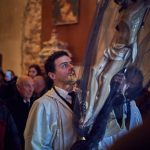Maundy Thursday is a special day on the island of Hvar due to the traditional Za Križen procession, which has been held every year for more than 500 years. This year, the traditional procession will take place in the central part of the island of Hvar on Thursday, April 18. The event has been included on the UNESCO World List of Intangible Heritage since 2009, reports morski.hr on April 15, 2019.
The procession begins every year at exactly 10 pm, starting simultaneously from Pitve, Vrisnik, Svirče, Vrbanj, Vrboska and Jelsa, returning to their starting points at 7 in the morning. Overnight, the participants cover about 25 kilometres. Cross-bearers apply for the role years in advance, sometimes even 10 to 20 years before.
This year, the cross-bearers are: Krišto Barbić in Pitve, Božen Grgičević in Vrisnik, Frane Carić in Svirče, Josip Bojanić in Vrbanj, Robert Čagalj in Vrboska, and Petar Bunčuga in Jelsa.
The cross-bearers are accompanied by a group comprising of two candlesticks (kandeliri) bearers, 6 to 12 heavy wax candles (torci) bearers, up to 30 lanterns (ferali) bearers, two companions which take care of the cross-bearers safety, two lead singers of Gospin Plač, and another 3-4 singers who sing the responses.
The preparations for the event start long before. The festivities begin on Ash Wednesday, when the 40 days of Lent begin, which include the singing rehearsals and the selection of bearers of kandeliri, torci, and ferali. It is customary that every person that the cross-bearer selects for his procession is visited personally by him at their houses. Cross-bearers wear shoes or woollen socks or walk barefoot, depending on their personal vows. It is customary that, at the very start of the procession, their family members pray for them and kiss the bearer and the cross.
Maundy Thursday includes a dinner for the cross-bearer and the party before they start, while on Friday morning there is the so-called “jutrina” for everybody who accompanied the bearer overnight. Also, most families from the cross-bearer’s town give them symbolic presents, such as cakes. After Easter, the cross-bearer’s helpers distribute cakes to houses in the parish.
The procession in Jelsa is different from the others since the cross-bearer concludes his procession by running over the local square after the procession returns to Jelsa. He is welcomed at the very end by the Jelsa priest. The bearer kneels with the cross, before returning to the church. Each parish has its unique features. For example, the cross from Pitve always visits another church located above Jelsa, while in other parishes this is left to the cross-bearers’ decision.
Many inhabitants of the island of Hvar mark Easter with this sacred tradition, and not just in the central part of the island since each town has its distinctive features. This cultural and religious event continues the tradition of songs which have been sung for five centuries with common melodies, but also with differences specific to each part of the island.
Translated from morski.hr.
More news about “Za Križen” procession can be found in the Lifestyle section.








